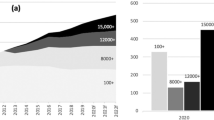Abstract
US West Coast ports have long been the principal gateway for container imports originating in Northeast Asia and destined for the Eastern United States. However, West Coast ports are losing market share to US Gulf and East Coast ports (USG&ECP). This study investigates the role oil prices may have played in the observed cargo shift. Logistic regression is used to predict the proportion of containerized imports from China shipped on the all-water route directly to USG&ECP based on trade data published by the US Census Bureau. The model employs three predictor variables: oil price, US West Coast labor strife and railroad rates. The model suggests oil price is positively correlated with the proportion of containerized imports from China shipped to USG&ECP and that oil price has a greater influence on the proportion of low value goods than high value goods shipped on the all-water route. Sensitivity tests based on model parameters are preformed to evaluate how future volatility in oil markets might influence maritime routing of containerized imports from China to the United States.















Similar content being viewed by others
Notes
Salt, Sulfur, Earth & Stone (25); Ores, Slag & Ash (26); Mineral Fuel & Oil (27); Fertilizers (31); Iron & Steel (72).
USG&ECP districts: Ogdensburg, NY; Buffalo, NY; Portland, ME; St Albans, VT; Boston, MA; Providence, RI; New York City, NY; Philadelphia, PA; Baltimore, MD; Washington, DC; Norfolk, VA; Wilmington, NC; Charleston, SC; Savannah, GA; Miami, FL; Tampa, FL; Mobile, AL; New Orleans, LA; Port Arthur, TX; Laredo, TX; Houston, TX; Pembina, ND; Minneapolis, MN; Duluth, MN; Milwaukee, WI; Detroit, MI; Chicago, IL; Cleveland, OH; St Louis, MO.
USWCP districts: Seattle, WA; Portland, OR; San Francisco, CA; Los Angeles, CA; San Diego, CA.
References
Association of American Railroads. (1990–2008) Railroad Ten-Year Trends. Washington DC: Economics and Finance Dept., Association of American Railroads.
Association of American Railroads. (2006) Railroad Facts. Washington DC: Economics and Finance Dept., Association of American Railroads.
Ballou, R.H. (2004) Business Logistics/Supply Chain Management: Planning, Organizing, and Controlling the Supply Chain. Upper Saddle River, NJ: Pearson/Prentice-Hall.
Energy Information Administration. (2009) EIA Petroleum marketing monthly: Monthly foreign crude oil acquisition report, http://www.eia.doe.gov/emeu/steo/pub/fsheets/real_prices.html, accessed 19 January 2009.
Gorman, M.F. and Conway, D.G. (2005) Logistics costs based estimation of freight transportation demand. Transportation Research Forum 44: 141–156.
Gosier, R., Simchi-Levi, D., Wright, J. and Bentz, B.A. (2008) Past the Tipping Point: Record Oil Prices Require New Supply Chain Strategies to Enable Future High Performance. Accenture/ILOG, http://www.accenture.com/SiteCollectionDocuments/PDF/PasttheTippingPointFinal.pdf, accessed 16 February 2009.
International Energy Agency. (2008) World energy outlook 2008, http://www.iea.org/textbase/nppdf/free/2008/weo2008.pdf, accessed 20 January 2009.
Leach, P. (2008) East Coast ports gaining cost advantages. Journal of Commerce, 4 March 2008. http://www.joc.com/node/400771 accessed 20 November 2008.
Luo, M. and Grigalunas, T.A. (2003) A spatial-economic multimodal transportation simulation model for US coastal container ports. Maritime Economics & Logistics 5: 158–178.
Menard, S.W. (1995) Applied Logistic Regression Analysis, Sage University papers series, no. 07-106. Thousand Oaks, CA: Sage Publications.
Pampel, F.C. (2000) Logistic Regression: A Primer, Sage University papers series, no. 07-132. Thousand Oaks, CA: Sage Publications.
Panama Canal Authority & The Louis Berger Group, Inc. (2003) The Panama Canal impact on the liner container shipping industry, http://www.pancanal.com/eng/plan/documentos/propuesta/acp-expansion-proposal.pdf.
Raine, G. (2008) Ship cargo volume slumping at West Coast ports. San Francisco Chronicle, 30 November 2008, http://www.sfgate.com/cgibin/article.cgi?f=/c/a/2008/11/30/BUC814CTLU.DTL, accessed 11 January 2009.
Stopford, M. (1997) Maritime Economics. New York: Routledge.
United States Department of Commerce, Economics and Statistics Administration, Bureau of the Census. (1996) U.S. Exports of Merchandise and U.S. Imports of Merchandise on CD-ROM, Product profile, no. 17. Washington, DC.
United States Department of Transportation, Maritime Administration & Transportation Economics and Management Systems, Inc. (2008) Impact of high oil prices on freight transportation modal shift potential in five corridors: technical report. Washington DC, http://marad.dot.gov/documents/Modal_Shift_Study_-_Technical_Report.pdf.
United States Maritime Administration. (2007) U.S. waterborne foreign trade by trading partners, http://www.marad.dot.gov/library_landing_page/data_and_statistics/Data_and_Statistics.htm, accessed 15 December 2008.
Vasquez, R. (2003) Economic forces in the decision-making process of the Panama Canal. Maritime Economics & Logistics 5: 219–223.
Veldman, S.J. and Buckmann, E.H. (2003) A model on container port competition: An application for the West European container hub-ports. Maritime Economics & Logistics 5: 3–22.
Washington Public Ports Association and Washington State Department of Transportation. (2009) Marine Cargo Forecast 2009. Technical Report, 23, March http://www.washingtonports.org/, accessed 7 April 2009.
Acknowledgements
The authors wish to acknowledge Professor Andre Punt, who provided crucial help with the statistical analysis, and funding provided through the Wedell O. Foss Fellowship. We are also grateful for valuable comments provided by two anonymous referees.
Author information
Authors and Affiliations
Rights and permissions
About this article
Cite this article
Zelasney, J., Huppert, D. & Leschine, T. The influence of oil price on maritime routing of containerized imports from China. Marit Econ Logist 13, 298–318 (2011). https://doi.org/10.1057/mel.2011.13
Published:
Issue Date:
DOI: https://doi.org/10.1057/mel.2011.13




